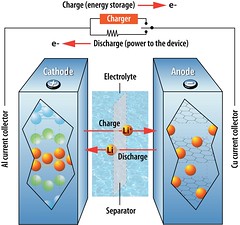A new technology could create a much more rapid charging time for lithium ion batteries
A research group at the University of Illinois has developed technology that may have lasting implications for electric vehicles (EVs) and other electronics.
The group, led by Paul Braun, a professor of material sciences and engineering, has come up with technology that creates a much more rapid charging time for lithium-ion batteries, which power electronics like cellphones, laptops and defibrillators. Lithium-ion batteries also power EVs, which can take all night to charge at home and up to an hour to charge at EV stations.
Braun’s findings, published last week in an online version of the journal Nature Nanotechnology, could lead to an EV charging time comparable to that for filling a tank of gas. Smaller objects like cell phones could charge in well under a minute, Braun said.
“We have batteries in the lab that can charge in tens of seconds,” he said.
When a battery charges, energy moves between its cathode and anode. When a battery powers a product, or discharges, energy travels the opposite way, between its anode and cathode. Braun’s group came up with a three-dimensional nanostructure for the battery cathode that allows its batteries to charge at a much faster rate than conventional batteries.









